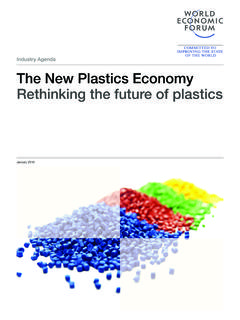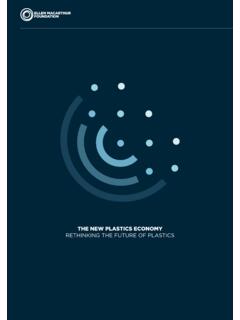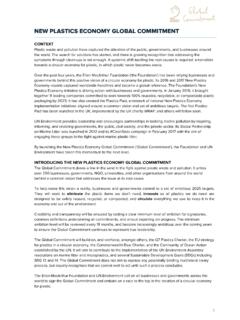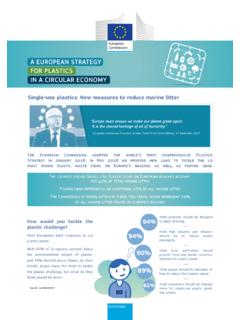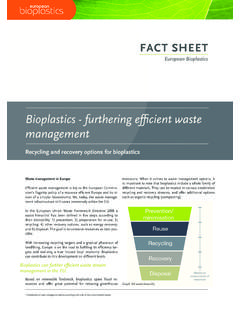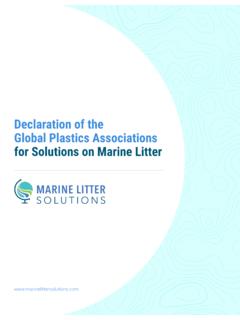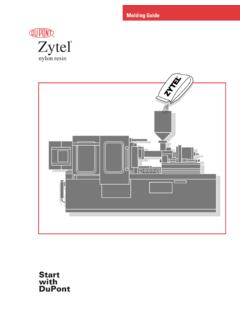Transcription of A EUROPEAN STRATEGY FOR PLASTICS IN A CIRCULAR …
1 1 ENA EUROPEAN STRATEGY FOR PLASTICSIN A CIRCULAR ECONOMY2A EUROPEAN STRATEGY FOR PLASTICSIN A CIRCULAR ECONOMY3 Table of contents1. INTRODUCTION .. 52. PLASTICS TODAY: KEY 63. TURNING CHALLENGES INTO OPPORTUNITIES: A VISION FOR A CIRCULAR PLASTICS economy .. WAY FORWARD: TURNING VISION INTO II ..21 ANNEX INTRODUCTIONP lastic is an important and ubiquitous material in our economy and daily lives. It has multiple functions that help tackle a number of the challenges facing our society. Light and innovative materials in cars or planes save fuel and cut CO2 emissions. High-performance insulation materials help us save on energy bills. In packaging, PLASTICS help ensure food safety and reduce food waste. Combined with 3D printing, bio-compatible plastic materials can save human lives by enabling medical , too often the way PLASTICS are currently produced, used and discarded fails to capture the economic benefits of a more ' CIRCULAR ' approach and harms the environment.
2 There is an urgent need to tackle the environmental problems that today cast a long shadow over the production, use and consumption of PLASTICS . The million tonnes of plastic litter that end up in the oceans every year are one of their most visible and alarming signs of these problems, causing growing public and improving the functioning of such a complex value chain requires efforts and greater cooperation by all its key players, from PLASTICS producers to recyclers, retailers and consumers. It also calls for innovation and a shared vision to drive investment in the right direction. The PLASTICS industry is very important to the EUROPEAN economy , and increasing its sustainability can bring new opportunities for innovation, competitiveness and job creation, in line with the objectives pursued by the renewed EU Industrial Policy STRATEGY .
3 In December 2015, the Commission adopted an EU Action Plan for a CIRCULAR economy . There, it identified PLASTICS as a key priority and committed itself to prepare a STRATEGY addressing the challenges posed by PLASTICS throughout the value chain and taking into account their entire life-cycle . In 2017, the Commission confirmed it would focus on PLASTICS production and use and work towards the goal of ensuring that all plastic packaging is recyclable by 2030. The EU is best placed to lead the transition to the PLASTICS of the future. This STRATEGY lays the foundations to a new PLASTICS economy , where the design and production of PLASTICS and plastic products fully respect reuse, repair and recycling needs and more sustainable materials are developed and promoted. This will deliver greater added value and prosperity in Europe and boost innovation.
4 It will curb plastic pollution and its adverse impact on our lives and the environment. By pursuing these aims, the STRATEGY will also help achieve the priority set by this Commission for an Energy Union with a modern, low-carbon, resource and energy-efficient economy and will make a tangible contribution to reaching the 2030 Sustainable Development Goals and the Paris STRATEGY presents key commitments for action at EU level. Yet the private sector, together with national and regional authorities, cities and citizens, will also need to mobilise. Similarly, international engagement will be necessary to drive change outside Europe s borders. With decisive and concerted efforts, Europe can turn challenges into opportunities and set the example for resolute action at global PLASTICS TODAY: KEY CHALLENGESOver the past 50 years, the role and importance of PLASTICS in our economy has consistently grown.
5 Global production of PLASTICS has increased twentyfold since the 1960s, reaching 322 million tonnes in 2015. It is expected to double again over the next 20 years. EUROPEAN PLASTICS DEMAND IN the EU, the PLASTICS sector employs million people4 and generated a turnover of EUR 340 billion in 2015. Although PLASTICS production in the EU has been stable in recent years, the EU s share of the global market is falling as production grows in other parts of the the EU, the potential for recycling plastic waste remains largely unexploited. Reuse and recycling of end-of-life PLASTICS remains very low, particularly in comparison with other materials such as paper, glass or metals. EU PLASTIC WASTE GENERATION IN 2015 Packaging 59%Non Packaging Household: 4%Construction and Demolition: 5%Electrical and Electronic Equipment: 8%Automotive: 5%Agriculture: 5%Others: 14%Source: Eunomia (2017)Around million tonnes of plastic waste are generated in Europe every Less than 30% of such waste is collected for recycling.
6 Of this amount, a significant share leaves the EU6 to be treated in third countries, where different environmental standards may apply. At the same time, landfilling and incineration rates of plastic waste remain high - 31 % and 39 %, respectively - and while landfill has decreased over the past decade, incineration has grown. According to estimates, 95 % of the value of plastic packaging material, between EUR 70 and 105 billion annually, is lost to the economy after a very short first-use Demand for recycled PLASTICS today accounts for only around 6 % of PLASTICS demand in Europe. In recent years, the EU plastic recycling sector has suffered from low commodity prices and uncertainties about market outlets. Investments in new plastic recycling capacity have been held back by the sector s prospects of low was estimated that PLASTICS production and the incineration of plastic waste give rise globally to approximately 400 million tonnes of CO2 a Using more recycled PLASTICS can reduce dependence on the extraction of fossil fuels for PLASTICS production and curb CO2 According to estimates10, the potential annual energy savings that could be achieved from recycling all global plastic waste is equivalent to billion barrels of oil per , Norway and Switzerland - Source.
7 PLASTICS Europe (2016)49 million tonnesPackagingBuilding and constructionAutomotiveElectronics7CO2 BENEFITS OF PLASTICS RECYCLING=Alternative types of feedstock ( bio-based PLASTICS or PLASTICS produced from carbon dioxide or methane), offering the same functionalities of traditional PLASTICS with potentially lower environmental impacts, are also being developed, but at the moment represent a very small share of the market. Increasing the uptake of alternatives that according to solid evidence are more sustainable can also help decrease our dependency on fossil fuels. Very large quantities of plastic waste leak into the environment from sources both on land and at sea, generating significant economic and environmental damage. Globally, 5 to 13 million tonnes of PLASTICS to 4 % of global PLASTICS production end up in the oceans every It is estimated that plastic accounts for over 80 % of marine litter.
8 Plastic debris is then transported by marine currents, sometimes over very long distances. They can be washed up on land12, degrade into microplastics or form dense areas of marine litter trapped in ocean gyres. UNEP estimates that damage to marine environments is at least USD 8 billion per year the EU, 150 000 to 500 000 tonnes13 of plastic waste enter the oceans every year. This represents a small proportion of global marine litter. Yet, plastic waste from EUROPEAN sources ends up in particularly vulnerable marine areas, such as the Mediterranean Sea and parts of the Arctic Ocean. Recent studies show PLASTICS accumulate in the Mediterranean at a density comparable to the areas of highest plastic accumulation in the oceans. Plastic pollution also affects areas of the EUROPEAN Exclusive Economic Zone, in the outermost regions along the Caribbean Sea, the Indian, Pacific and Atlantic Oceans.
9 In addition to harming the environment, marine litter causes economic damage to activities such as tourism, fisheries and shipping. For instance, the cost of litter to EU fisheries was estimated at about 1 % of total revenues from catches by the EU ,000 TONNES OF PLASTIC IN THE OCEANS=66,000 rubbish trucksThis phenomenon is exacerbated by the increasing amount of plastic waste generated each year, also fuelled by the growing of single-use PLASTICS , packaging or other consumer products that are thrown away after one brief use, are rarely recycled and prone to be littered. These include small packaging, bags, disposable cups, lids, straws and cutlery, for which plastic is widely used due to its lightness, low cost, and practical features. Recycling 1 million tonnes of plastics1 million cars off the road8 New sources of plastic leakage are also on the rise, posing additional potential threats to both the environment and human health.
10 Microplastics, tiny fragments of plastic below 5mm in size, accumulate in the sea, where their small size makes it easy for marine life to ingest them. They can also enter the food chain. Recent studies also found microplastics in air, drinking water and other foods like salt or honey, with yet unknown impacts on human total, it is estimated that between 75 000 and 300 000 tonnes of microplastics are released into the environment each year in the While a large amount of microplastics result from the fragmentation of larger pieces of plastic waste, significant quantities also enter the environment directly, making it more challenging to track and prevent addition, the increasing market shares of PLASTICS with biodegradable properties bring new opportunities as well as risks. In the absence of clear labelling or marking for consumers, and without adequate waste collection and treatment, it could aggravate the existing problem of PLASTICS leakage and create problems for mechanical recycling.










